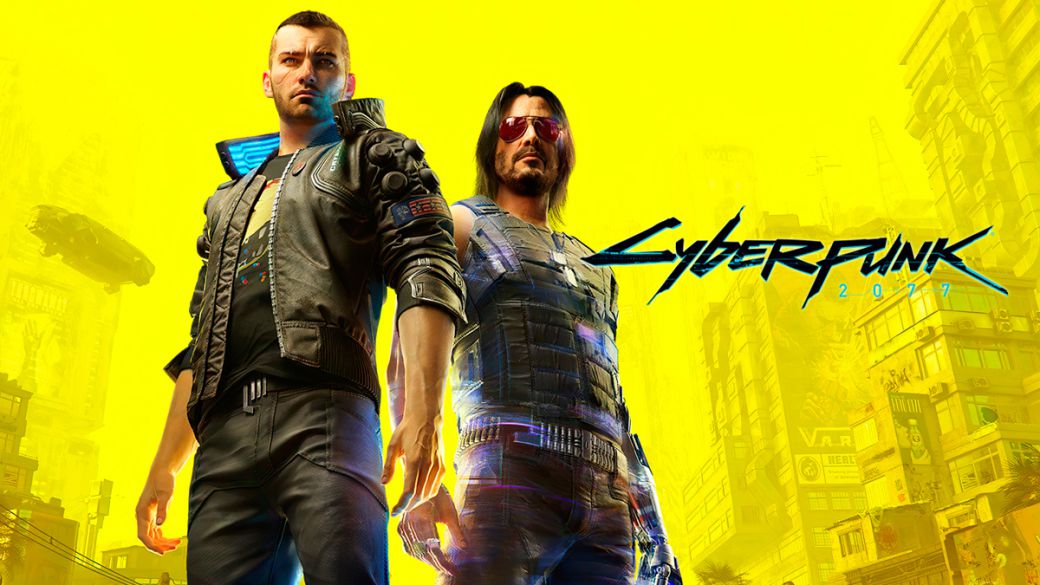
CD Projekt does it again, to go further than anyone else and to lay the foundations of excellence for the coming years.
Since the sandbox and open worlds began to prevail in the most luxurious and demanding sector of the video game, the extent of the map has been one of those easy metrics to throw in promotions. Although the presence of procedural games makes it practically impossible to compete for the first place, the total area still retains a certain aura of prestige. However, and focusing on the open games of the urban environment, the extension has never been enough to fully recreate the sensations that a big city produces.
Let’s think about the first time we visit one of the great cities of the world: New York, Tokyo, London, Hong Kong … we review our individual sensations when we find ourselves in some of its nerve centers: Times Square, the Shibuya intersection, Piccadilly … Yes, we know that the city extends to vast distances, but that is not what impresses at those times. What we feel in the triple shock generated by the crowd around us, our smallness before the monumental structures that surround us and the sensory saturation of noises, stimuli and lights that invite us to experience, consume or live the hundreds of options that are unfold before our crowded senses.
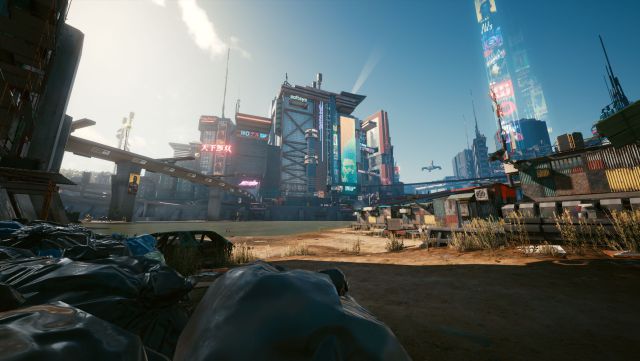
Playing those moments in a video game is complicated, mainly because the scale of our character with respect to the world is not comparable to the real one for both technical and practical reasons. There are magnificent examples that manage to recreate their spirit, their history and the image they evoke through their relevance in other visual media, but they cannot come close to scale or true density. Nor is it easy to recreate in the video game some of the elements that give big cities their magic: their infinity of opportunities and microverses stacked in a few square meters, the whimsical combinations between centuries-old tradition and the inexorable pace of urban development, or those Impossible contrasts between dynamism and stillness that can emerge in every corner, as if by magic.
If that approach, in that pale reflection that are the virtual cities of the video game, are some of the main achievements of the medium when it comes to creating virtual environments, how could the task of reproducing Night City be considered? How to propose the scale of a futuristic megalopolis conceived as a dream that brings together the best and especially the worst of contemporary cities, multiplied to the nth degree? For CD Projekt the answer to this becomes evident as you play Cyberpunk 2077: with work, passion and more work, with nine intense years of development whose most obvious initial result is to have turned all the urban open games that have been into dollhouses. appeared in the history of the video game so far.
“Live on the edge”
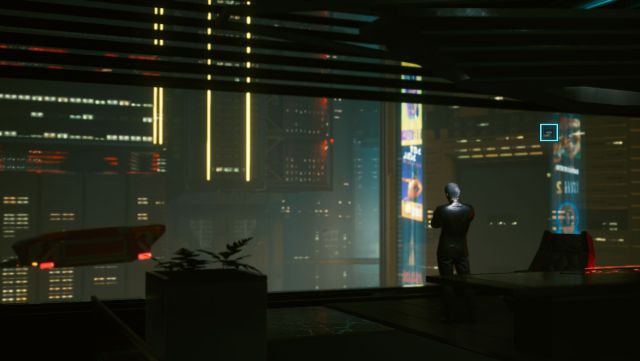
Among the fundamental elements to be a cyberpunk in the 2020 rules, was that of “live on the Edge”, living on the edge, in an area where you risk your money, your reputation and even your life on something as vague as a principle . That principle seems to have transcended the pages of the role-playing game to take over CD Projekt as a studio and set the goal of setting a new benchmark when creating scenarios. Touring Night City is recreating one of the greatest works of digital architecture ever made in the video game, an exercise in fantasy that tries to capture the soul of the fictional Californian city, today little less than a city-state under the iron influence of the Arasaka corporation.
Opulence and misery, splendor and dirt, rich constructions assaulted by the rebellious power of graffiti as the last bit of protest against the incontestable power of the powerful. “They are wet streets, foggy nights, cars, faceless people doing the things they do”, as Mike Pondsmith said in that long-ago video from January 2013, when he made what was a manifesto of what he wanted the Cyberpunk 2077 video game and why he had chosen CD Projekt when he had already rejected several attempts to make video games with the license. “They were fans, they knew the material better than I remembered,” he saw something more in them than wanting to license a recognized name to make one more game. A faith that has been fully endorsed, with a true turning point in the video game.
The recreation of Night City is overwhelming in its scale, in its verticality and density. From the first moment we step out of our apartment in Watson and step freely on the stairs of the Megatorre where we live, we find a city like we have never seen it in the video game. Its streets are full of life, not only with pedestrians from one place to another, but with shops, street food stalls, people chatting, paying attention to a shop window. Despite the fact that the size of the city forces us to use vehicles to get from one place to another, the team has ensured that all areas also make sense for pedestrians, with their generous sidewalks, zebra crossings and traffic lights, elevated walkways to cross roads, alleys to cut through and dangers in the shadows. It is convenient, from time to time, to do the exercise of leaving the vehicles and dedicating ourselves to walking quietly through the streets, appreciating the efforts that have been made in creating a scene that is not only appearance but is staged with purpose and attention retail.
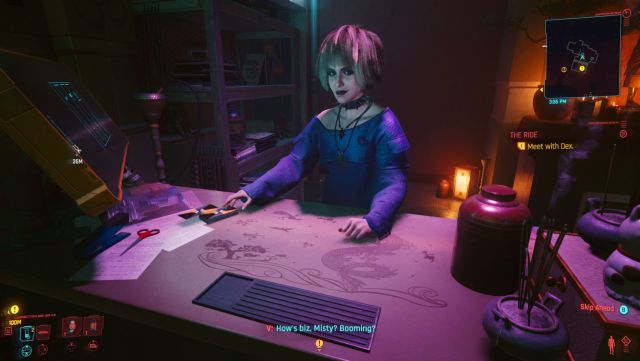
Streets on streets that must be accessed by urban lifts, indoor markets, patios that unfold as a surprise in the most unexpected areas, stairs that meander to access intermediate areas out of sight of the general public, places to order something from eating or drinking … both by vehicle and on foot, Night City gives off life in its streets, with enough variety of pedestrian models, animations and costume sets to deceive our senses. But what most catches our attention is the scale of the buildings, the general complexity of some streets, which go up and down, intermingle according to the needs, design and type of population of each area. We feel like when a game pulls a pre-rendered landscape in the background to evoke that we are in a larger and more complex place than we are allowed to explore, with the difference that here everything we see “exists” is an explorable part of a mapping that we can explore at will. They say that one of the most common traits of a tourist when he arrives in New York (and with which one must be careful in order to avoid pickpockets), is that of constantly looking up due to the impact of being inside the Big Apple. Here we feel a similar impulse.
The best of each house
When it comes to describing Cyberpunk as a playable experience, different references come to mind. On the one hand, it is unquestionably a role-playing game, with full freedom to create and develop our character, make decisions about the events that unfold around us and face the consequences of them according to the role we want to play. At the same time, it presents a real-time combat system that is similar to any shooter, with complete aiming and cover mechanics that allow us to face our opponents directly. But we also find elaborate infiltration and stealth mechanics, which are particularly reminiscent of current Deus Ex installments, something that we also appreciate in some missions with different alternatives depending on our strengths and observation capacity. Of course, the essence of GTA is also appreciated when we are on the road, although with some specific considerations (we can steal according to what type of cars based on our attributes, since there are more elaborate security systems than others).
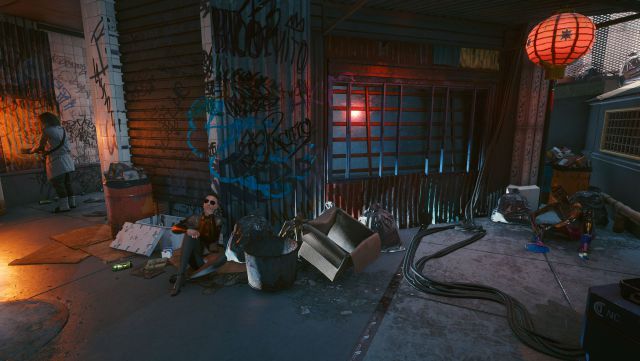
Far from suffering Frankenstein syndrome from assembling so many important pieces, here they appear harmonized as if it were something natural, which also has a gigantic merit. There are reasons why the RPG components that Rockstar tried to implement in San Andreas are so lukewarm that they were never taken up again, or why it is difficult to create an open and navigable city in Human Revolution. To all this we must add an effective progression of our character to be able to deploy different specialties, dozens of characters with voice and different dialogue options that change according to the attributes or origin of the protagonist, missions with different alternatives to be completed and varied mechanics that they They give freshness to not always be the same. Combat in real time with various subtypes of weapons, modifications and a long list of attributes and effects to apply to our rivals. All this adapted to an open game that on the other hand maintains a dense and elaborate personal story full of great moments. The naturalness with which all these pillars are present could make us think that it is something “easy”, but in reality it is extremely difficult and an important reason why the game has been in development for almost a decade and has suffered several delays. There is nothing easy about this structure bearing the weight of its own ambition and for all the pieces to function properly and even shine.
A universe of stories
In order to make the game more manageable for a wider range of people, CD Projekt has fragmented the missions better than in The Witcher 3, so that each player can go at the pace that is most convenient for them. On one side is the main story, divided into different fragments with bridges between them. Then there are “secondary gigs”, which can be single missions of varying sizes or important subplots of various episodes that are not main but seem so. On the other hand are the commissions. Each area of the city has a reference fixer, an intermediary who connects clients with operatives capable of meeting their needs; the higher your reputation, the more jobs you will receive and the more money you will earn from them, although the difficulty increases accordingly. In addition to that, a NCPD police force scanner will show you where altercations are taking place so you can go help out if you want an extra source of income, not to mention the number of thugs you can encounter when you get out of your way a bit. busier areas. As if all that were not enough, the map is full of mysterious points, short events that can entail some danger (all missions are associated with a degree of danger that changes in relation to the progression of your character).
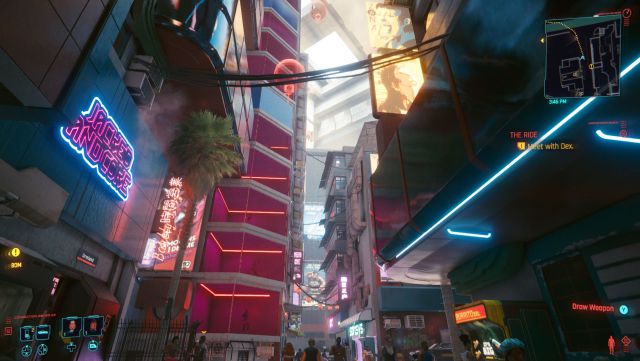
The volume of activities that we can undertake has not been an excuse for CD Projekt to have made an effort to give them the importance they deserve. We can always find interesting dialogues, curious situations and unexpected twists. What was a boring mission on paper can turn into a gripping story when you least expect it, or help you understand the world you are in and its people. The team has taken care of both the design and the story, either in the main or in any of the “secondary” so that there are enough elements not to fall into monotony. This has a lot to do with the way the narrative is cared for in the Polish studio and how it influences the action and the mechanics themselves, and not the other way around as it happens in many other open games, where the story seems many times a more or less elaborate color note to do the same as always.
A proper balance of mission variety has been found, preventing things like the monotony of looking for clues and footprints from repeating themselves in The Witcher 3 (an element also present here, but in a much more reasonable way). There are missions of sabotage, stealth, robbery or pure combat, as well as stories that use their own mechanics implemented for the occasion. That harmony between design and narrative is what elevates the whole, although the master touch is when you manage to reach emotional heights with characters that you care about. Without going into details, suffice it to say that CD Projekt continues to lead the way in how to do things when it comes to storytelling in AAA games and to be at the top when it comes to this issue.
Proof of this are the missions based on braindance, recordings with special equipment that allow millions to put themselves in the shoes of another, see, feel, smell and taste from another point of view, from the safety of your home. Needless to say, humanity being as it is, porn and erotic content is one of the most demanded applications, when they are not the most sinister cons. Using an editor, we can go through these scenes in the third person and look for clues in different registers to solve narrative “puzzles” that give us useful information about the mission we are undertaking. It is an elaborate mechanic, that is used just enough and that manages to give more richness to the campaign with something that has no more application in the rest of the game. It is not the only example by which we consider that CD Projekt manages to find a better balance than in The Wild Hunt, but it is one of the most significant.
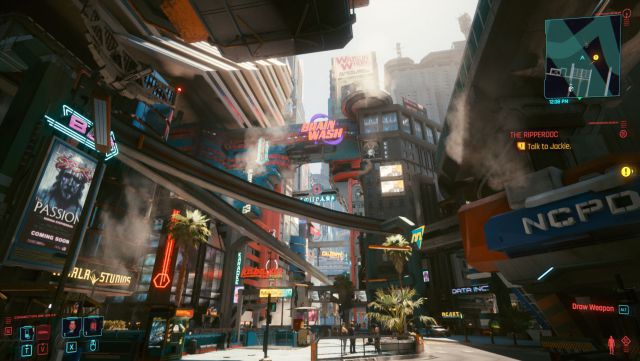
“Attitude is everything”. Creating and developing your character
Cyberpunk 2077 is committed to an open creation and development system, where the player’s will is mixed with the direction they want to take their own practice in real situations. We have a very complete editor to customize our character – we will not see it continuously because it is in the first person, but there is a fairly visible use of mirrors, in addition to other scenes in which we can see ourselves. Once this is done we will be able to choose our initial attributes, to be divided between constitution, reflexes, technical ability, intelligence and mettle. The attributes are the thick outline of the character definition, general aspects that also serve to determine if we can use different dialogue options or to perform some actions such as force doors thanks to our powerful constitution, manipulate a system thanks to our intelligence, release a lapidary phrase thanks to our mettle or stealing a car with our technical knowledge, to give a few examples. Of course there will always be alternatives to these special actions, in case they don’t give us the numbers, but when we can do them we will find extras, shortcuts and bonuses that will make us feel proud of our decisions.
Once we begin to assign points, the fine lines begin that materialize in the so-called “advantages”, which is where we can better define what we want our character to do and where our own experience will be reflected to earn bonuses. Each group of attributes is divided into two or three subgroups of related advantages, each with a score of improvements, effects and new abilities that enhance specific aspects of the range of possibilities that we have at our disposal. For example, reflexes is divided into assault, pistols and bladed weapons, so that if what we want is to be a master of the katana, we must put extra points in the reflexes attribute, use advantage points to earn bonuses in the use of sword and also accumulate experience with that specific weapon to unlock passive extras. The combination of intention and experience will make us more resistant, faster and do more damage when we brandish a sword, making it functional in a world where ranged weapons clearly dominate. Of course, putting points there will not suffice. Putting points in constitution to increase your resistances, life and regeneration capacity will also be essential if we want to go to melee, although in general we recommend keeping a good range of open possibilities and also putting some points in some type of ranged weapon to be more versatile.
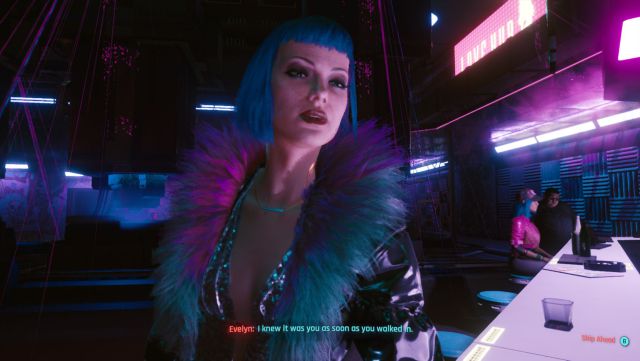
The advice to be something multidisciplinary also extends to other facets such as stealth. In mettle is the stealth specialization, important both for those who want to go unnoticed and for those who want to attack from the shadows. But focusing solely on that facet can prevent you from having the strength to unlock the door that will save you an entire section of enemies, or not putting points on intelligence will prevent you from having such useful skills as disconnecting cameras from a distance or distracting enemies by manipulating electronic objects. The possibilities of synergies between attributes and the wide possibilities of obtaining interesting bonuses make growing your character always interesting, also leaving room for future games with another class of protagonists.
To all this must be added a huge amount of equipment. There is a wide range of weapons: pistols, assault weapons, semi-automatic, sniper rifles, shotguns … all with different degrees of rarity, so that the rarest ones usually have added effects such as toxic or associated fiery damage, multipliers for damage in the head. There are even smart weapons, capable of firing bullets that hunt down your enemies. The models remain constant throughout the game, although the damage of the individual weapons that we find increases as we level up, so we can find some of a unique manufacture that we have to replace with simpler ones for the mere fact of that the damage scale is not comparable (fortunately, we can also improve this weapon linearly if we have the right components, so we won’t have to get rid of it if we especially like it). In fact, it seems to use a “soft” system of scale, in which it is possible to find missions and enemies that are too hard for our abilities, but at the same time we do not reach a point where combat or solving missions is irrelevant, although yes easier.
Our character will also have the option of manufacturing their own weapons and supplies, as well as improving the ones they already have. The huge loot that we will collect can be sold or recycled into essential components with which, if we have the right plan, we can create our own weapons, ammunition or consumables to recover health. There are also modifiers for the weapons that support it: different types of sights, silencers and chips that achieve different bonuses or alter the functionalities of the weapon (one option is to equip a chip that turns the weapon in question into non-lethal, at the cost of losing multipliers headshot damage). In any case, we miss more customization capacity when it comes to manufacturing, since there is no creative or decision component in this process, it is simply limited to a case of knowing if we have the necessary plans and components. We also miss more modules and accessories that turn our favorite weapon into another expression of our capabilities, but you can’t have everything. Manufacturing in Cyberpunk is more oriented to be utilitarian and as part of the game economy than as an outstanding facet, more in the background, although with its usefulness if you know how to look for it.

Combat in Cyberpunk 2077
When entering combat, the ferocity and agility of it stand out. There are four levels of difficulty and we decided to play it on the third, on hard, looking for something other than a ride. And faithfully it has not been a walk, especially the first hours. At that level, the impacts of the weapons hit hard and the life bar volatilizes without reaction capacity as soon as you expose yourself or do not cover yourself well from enemy shots. That forces you to be precise, to use a little infiltration to look for good points to bet on, to aim well looking for the enemy head and to move with intelligence so as not to be a fairground duck. Many times we will find combat in wide open spaces, with snipers, turrets and other resources that will make it more difficult for us if we do not pull stealth and / or hacking to make things a little easier (although if we want to be a tank with a heavy weapon in the hand, surely you can create a suitable build for it also for those who do not prefer to complicate their lives).
The sensations are very good, for practical purposes it looks like just another shooter, with the additional considerations of the damage points according to bonuses and impact zones (some numbers that we can remove from the interface if we prefer). Enemies move reasonably well, seek out your francs, and lean on each other so that combat dynamics are never boring. Visually it is also remarkable, the weapons are generally satisfactory to shoot, they have fabulous loading animations and the effect of the bullets is noticeable in the environment, all contributing to satisfactory sensations as a shooter with a tactical and role-playing element. , although it is certainly not a game designed for a tactical mind looking for a challenge, nor for virtuosos of the pad, focusing more on something with universal appeal, that a large sector of fans can enjoy. It has the right approach to leave different courses of action, so that each one finds their appropriate difficulty and favorite style of play
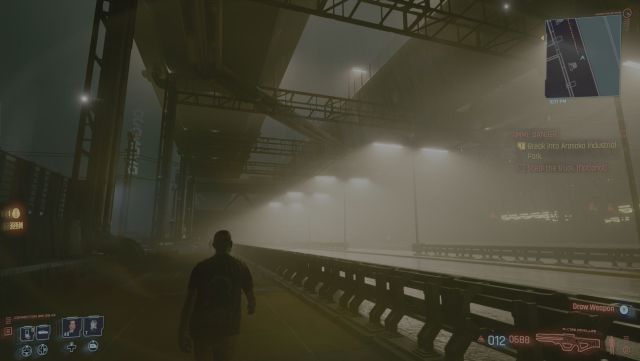
Running more than your problems
An essential part of the charm of Cyberpunk 2077 is in its vehicles, in traveling through Night City with them from end to end and expanding our collection. Although we can steal cars from others, both parked and running (if we have the right attribute), the truth is that once we lose them or they are destroyed we can no longer recover them and there are no workshops to repair them. On the other hand, the cars that we acquire fully, whether they are in certain points on the map, those that we receive as gifts or those that we buy, will be ours forever and we can call them to come and pick us up at (almost) any point on the map. and in perfect magazine condition.
Each vehicle has a different behavior. Suspension, steering, acceleration, top speed … There are noticeable differences in the wide variety of “mounts” that we can use. The fact that an interior view has been incorporated from the beginning for each of them also contributes to raising our appreciation thanks to the recreation of their interiors, in which details have not been spared in order to make the experience of owning a vehicle complete. Obviously we are not talking about a Forza or a Gran Turismo, but the control and driving sensations are good, with that arcade touch that you would expect from an open game. The first person mode is a bit difficult to go through star caches, with a lot of traffic or steep turns, but the immersion it produces when we can afford it is fantastic and we can alternate between third and first person at will depending on the circumstances. When we played it for the first time a few months ago, it was one of the aspects that most concerned us because of how orthopedic things like turning were, but it is clear that these months of work and delays have not been in vain and the result is an experience of control. satisfactory.

Inventing the sound of 2077
We’ve already talked about elements like immersion, scale, and the overall richness that Night City exudes. But an important element in the equation is music. Awakening nostalgia and evoking a specific time thanks to the power of licensed music is one thing, not easy but possible with enough resources and will. But that is not valid to recreate a future that is yet to come, so the idea of CD Projekt has been as curious as it is original: hiring recognized artists to adopt alternative personalities in that dystopian future, creating new themes designed for him. The different chains that we can listen to cover a good variety of genres that seem appropriate for the times: hard rock, commercial, nostalgic themes, different variations of electronics, trance, synthwave of course, Latin … that sound permeates the streets of the city, which together with the themes devised for the story and defining moments, makes the musical value of Cyberpunk 2077 enormous and trendsetting. Like everything and depending on your tastes, you will find things that you like more and others less, but there are very good melodies and, most importantly, their value creating atmosphere and authenticity is incalculable.
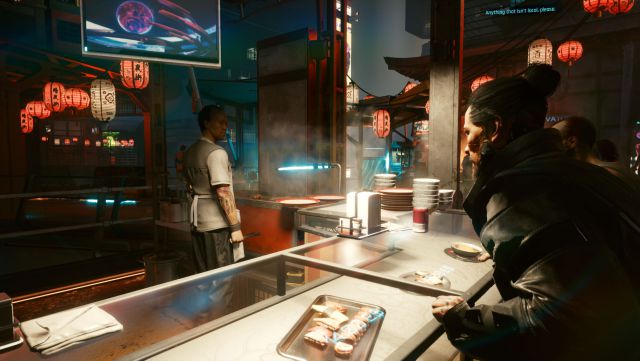
The future is yet to be written
We’ve played on PC and given the ambition, size, and complexity of the overall mission design, we actually expected to see more bugs and imperfections than we’ve encountered. Of course there are, and more that will come out once the “testing” of the general public begins, but the experience is solid within a game with normal behavior. The open nature of the title will provide a multitude of challenges, funny glitches and other phenomena typical of our current shared video game experience thanks to streaming and the general exposure that some games have, but we have not found serious errors that impede our progress through the different missions .
Graphically it looks very good, partly because of the aesthetic considerations that we have already mentioned, because of the feeling of being really submerged in a big futuristic city. Performance is good, and there are plenty of configuration options to make sure we hit a good compromise between performance and image quality. The different options to set the framerate to what we want are particularly useful, giving it the space to maneuver to dynamically alter the resolutions so that it has room to avoid losing frames along the way with imperceptible changes in resolution, a very helpful technique in consoles and that on PC will be seen more and more as real-time readjustment techniques improve more and more.

We can’t stop thinking about what the game will look like next year, once the “new generation” version more geared towards new cards and consoles appears. In the absence of knowing first-hand how is the performance of Cyberpunk 2077 on current consoles, it seems to us a small miracle that a game with these dimensions, without intermediate loads, with this scale, amount of details and objects on the screen, reaches machines with so much time on, although it will surely be noticeable in things like the number of vehicles and passers-by on the screen. In any case, going forward, that promised free patch for next year will be very interesting to see, given the present we have on our screen.
Clearly this impressive virtual representation of Night City was not created for a game and that’s it. Surely CD Projekt has big plans in the form of free patches and expansions, as it did so well with The Witcher 3, in addition to that independent multiplayer mode that can become something very big seen. But that is the future, the important thing is that the present, the reality of these nine years of development, is a special game, capable of turning upside down our conceptions of what we expect when we explore a city in a video game.
CONCLUSION
It had to be a monumental task to build this “city of dreams” and also populate it with passionate stories and characters, fantastic music and a captivating personality. Shortcuts to greatness are extremely rare, and the steadfast and safest path remains hard work, passion, and the desire to create something that surpasses others, with the right resources to do so. CD Projekt could have rested on The Witcher’s laurels, made more sequels, and released a couple of best-sellers in the time it took Cyberpunk 2077 to finish, but that’s not the path of the Polish studio, driven by more ethereal goals. Money, yes, and success, but leaving a mark too. Glowing brightly in the intensity of the night. Making history before our eyes.
THE BEST
- Night City, the most impressive city in the video game
- Great balance, variety and richness of missions, great game pace
- The atmosphere, the music, its capacity for immersion
- Another fantastic set of stories by CD Projekt
- Multiple possibilities both in combat and outside of it
- The internal dynamics of the protagonist, with some very emotional moments
WORST
- Hand-to-hand combat could be more forceful and rich
- Arms manufacturing would win with more chances
Masterpiece
A masterpiece that has mastered its genre to place itself on top of it. A colossus of his generation that will continue to be commented on and remembered in the future. The maximum note does not imply perfection, but is used to point to an absolute reference in which others can and should look at each other.
